2017-09-03 by Ed Timperlake
This article argues that payload utility can be a driver for understanding the future development of combat systems.
To understand Pu with full honor to John Boyd, it can be noted that Observe/Orient (OO) is essentially target acquisition, and Decide/Act (DA) is target engagement.
Thus there is a very simple formula, better and better TA and TE =more effective employment of all payloads available to the battle commander.
It is the process of understanding the huge complexities in such a simple formula that is the challenge.
In this article, I introduce these concepts as a way to understand how to shape and execute the kill web, or the distributed combat learning and engagement force.
Introduction
Prevailing in high-intensity combat is the seen in the differences between combatants.
The quality of uniformed military personnel is critical, and the ability to mobilize rapidly and effectively is crucial.
The tactical skills of combat leaders at all ranks are essential, and the correct focus on constant appropriate training makes it all come together.
U.S. military doctrine must always be dynamic enough to empower all the crucial intangible components when war breaks out.
In some nations, a sophisticated new weapon system can substantially augment the capabilities of its operators.
In other nations, that same weapon system can overwhelm its operators and prove virtually worthless.
Similarly, one country may have the determination to extract the maximum potential from its weapons, while another with similar skills may lack the motivation, leadership and focus on training, training, and training, to exploit those same weapons.
If one was forced to measure either the capabilities of the weapons or the capabilities of their operators, the greater and more useful insight might be derived from the latter.
But there may be a way to combine military technology and the human intangible factor very simply, which is defining a Payload Utility Function.
Having sat through the late Colonel John Boyd’s famous lecture twice, I developed a real appreciation first hand of his creating one of the most widely embraced ideas about combat dynamics ever formulated.
In those days, there was a significant adverse reaction against the F-4 Phantom II aircraft.
The complaint was that as originally designed it was a high-altitude interceptor.
In fact, in early pictures the two man crew Pilot and Radar Intercept Officer were depicted wearing high altitude pressure suits.
The primary weapons were missiles, the AIM-7 semi-active Sparrow and the IR fire and forget AIM-9 Sidewinder.
The early Phantom T/M/S had no gun.
In addition the cockpit was, relatively speaking, not maximized for looking out the window; it was almost a sunken cave.
Of course, the F-4 went on to be a very capable multi-mission fighter-bomber with 5,000 produced for many nations Air Forces.
The Phantom rapidly morphed from just an Interceptor to a “dog fighter” (it took Top Gun, the USAF Fighter Weapons School and the Israelis with many hours in type to be the best) and a Direct Air Support or deep interdiction aircraft and in Marine hands, became a formidable Close Air Support platform.
For example, a section of F-4s armed with four shot Zuni Rocket pods had a greater initial “broadside potential” of a WW II Destroyer’s main weapons firing their 5 inch 54 gun mounts in an opening salvo.
Colonel Boyd had a real issue with the aviation design teams that in addition to the F-4, gave the USAF its famous Century Series, the F-101, F-102, F-104, F105, and F-106.
The comment was often made in those days by USAF Fighter Pilots, “Why are we flying Navy aircraft?”
In addition to the F-4, the USAF also had the Navy developed A-7.
John Boyd brilliantly challenged all designers too essentially replicate his great success in flying the F-86.
He made a very cogent case in claiming that modern fighters needed a “bubble” canopy and the best relative “energy maneuverability” possible as more powerful engines were being developed.
Boyd stressed P sub s diagrams.
Ps simply allows comparisons of aircraft at different altitudes to essentially see where the different “edges of the envelope” advantages existed.
With that knowledge and practice and being competently flown, a fighter pilot would have a significant advantage in engaging.
Understanding relative platform energy maneuverability, especially in F-15, F-16 and F/A -18 improvements in airframe/wing design and engine performance, would give a fighter pilot a significant advantage in a 1 V 1 “Knife fight ” up to to “fur ball,” which is colloquial term for a swirling engagement with many bogies and friendlies.
Using P sub s charts the pilot would know where to optimize the fight to gain an advantage.
To Boyd, visual lookout was essential and he was totally correct.
Finally, Section (USN/USMC ) or two ship USAF and Division (USN/USMC) or four ship (USAF terminology) pairing tactics become a huge consideration.
Boyd again got it correct — a “Bubble” canopy would make a huge difference in keeping mutual support and look-out doctrine in any air-to-air engagement.
Essentially his OODA (Observe, Orient, Decide and Act) began with looking out see the enemy, orient the fighter, decide if an advantage exists, OR not, and then act employing knowledge of the human/machine capability.
The remarkable combat success of the F-15 Eagle Fighter Pilots of over 100 to zero kill ratio owes a debt of gratitude to the late Col John Boyd USAF (ret).
The Mobilization/Modernization Dynamic
In the design era of Boyd’s OODA formulation another technological imperative was just beginning to be seen — advanced weapon designs.
Perhaps the best combat example is the successful laser-guided bomb attack on the Paul Doumer Bridge in the later days of the Vietnam War.

John Boyd was very concerned with Observe, Orient, Decide, Act and his Payload was essentially the squeeze trigger of his platform the gun.
From the history of Korea and MIG Ally:
The F-86 entered service with the United States Air Force in 1949, joining the 1st Fighter Wing‘s 94th Fighter Squadron and became the primary air-to-air jet fighter used by the Americans in the Korean War.
While earlier straight-winged jets such as the F-80 and F-84 initially achieved air victories, when the swept wing Soviet MiG-15 was introduced in November 1950, it outperformed all UN-based aircraft. In response, three squadrons of F-86s were rushed to the Far East in December.
Early variants of the F-86 could not outturn, but they could out dive the MiG-15, although the MiG-15 was superior to the early F-86 models in ceiling, acceleration, rate of climb and zoom.
With the introduction of the F-86F in 1953, the two aircraft were more closely matched, with many combat-experienced pilots claiming a marginal superiority for the F-86F.
The heavier firepower of the MiG (and many other contemporary fighters) was addressed by fielding eight cannon armed Fs in the waning months of the war. Despite being able to fire only two of the four 20 mm cannon at a time, the experiment was considered a success.
By adding a “Payload Utility” function to the OODA dynamic, we can recognize the important growth of fighters from just a motor, a “bubble canopy, and a gun sight to embracing the important technology evolution/revolution of weapon design that advances how a nation’s military can put all the pieces together with a central unity of purpose.
Focusing on Payload Utility can drive the appropriate integration of platforms and people in to the modern battlefield OODA loop.
The payload function is a critical determinant of combat success.
Any enemy of America that thinks our Joint Staff and the planning staffs in our Combat Commands do not have a firm understanding of the effects of munitions does so at their mortal peril.
In fact the greatest payload utility Airpower campaign “death from above” in history was Desert Storm.
Those planners were gifted in mixing and matching the utility of various payloads.
I have emphasized in my work, the innovations driven by the squadron pilots in thinking about the con-ops necessary to shape combat innovation.
In the Desert Storm, case then Lt. Col. David Deptula exemplified how such innovation occurs and allows for the air enabled combat force to innovate and shape a war winning force.
Just like the recent MOAB in Afghanistan and the 59 out of 60 missile “shacks” launched by USS Porter and USS Ross against Syria, the individual and combined use of all American ordinance is well known and has been successfully used in combat.
From the Initial Jet Age to the Fifth Gen World
One command published a very smart payload document: “Commanders Handbook for Joint Battle Damage Assessment”
This publication was from the Joint War Fighting Center that became Joint Forces Command headed by General Mattis before then JFCOM was stood down.
http://www.dtic.mil/doctrine/doctrine/jwfc/hbk_jbda.pdf
Payload utility (Pu) in the terms of this think piece is seen as the end result of many human decisions aided by technology.
It is an attempt to bring together with a unifying central focus for analysis a coherent interconnected vision capturing both a shift in looking at legacy systems and a way ahead in modernization programs.
Modernization and mobilization must both exist in harmony.
There needs to be a mobilization planning and requirements focus at the Office of the Secretary of Defense level focusing on consumption rates, battle damage repair attrition analysis and the real industrial base response capability.
The evolving modernization and mobilization dilemma is to understand the dynamic and rapidly changing combat engagement thinking in melding legacy systems integrated with sensor-shooter 5th gen software upgradeable platforms.
The technological imperative to fully understand Pu (unfortunate paring of letters) in a much larger sense is very time sensitive critical, with Hyper-Sonic Cruse Missiles (HSCM), Directed Energy (laser systems) and possibility of USN “rail-guns” arriving soon.
The sum maybe greater than the parts if a new analytical paradigm of Pu is understood correctly.
After WWII, the jet engines started the same dynamic seen in the prop years –improved airframe system performance by improving speed, range and maneuverability.
But two new dynamics were added both related to “payload.”
For a fighter in WWII, the “payload” was simple –what caliber and how many machine guns or cannons fit the design to give the pilot enough “deadly bursts” to kill several of his opponents.
In the jet age, the complexities of adding airborne systems and improving the weapons carried, changed the technology vectors of design considerations and introduced two more synergistic, but relatively independent research and development paths.
Airborne radar and sensors were added to fighters and those systems helped the payload—guns and early IR fire and forget missiles became more efficient with the AIM 9 sidewinder series.
But then, concurrently, independent performance was put into the payload by improving missiles and linking long-range (BVR) missile shots to radar technology.
At first, radar guided missiles needed continuous guidance from the fighter but eventually even radar guided missiles became BVR self-contained “fire and forget.”
So unlike WWII research and development, where research on airframes and engines was the mantra, in the jet age there were two other huge design factors at work.
The first was always questing to improve the radar systems in the fighters and, secondly, as technology allowed independent designs could improve the weapons carried.
Yet again, the art of aeronautical design had to work in partnership with the science of military R&D.
Along the way survivability shifted from armor, speed, and focusing on a good canopy into the era of Electronic Warfare and now the incorporation of stealth characteristics through both design considerations, composite materials and the wonders of chemistry for paint.
Stealth is a survivability factor and is critically important because it multiplies the effectiveness of the fighter—one doesn’t add stealth but incorporates it into the very existence of the fighter.
Being a multiplying factor means it is sensitive and can really drive the entire performance of the airframe and system combat performance.
So ending the 20th Century the complexities of fielding the best fighter was a much bigger challenge because of three synergistic but independent factors–basic airframe performance improvements, internal system R&D and constantly improving weapons.
Like John Boyd using his F-86 experience to formulate the OODA loop, the F-35 can be the starting point for understanding the unifying and driving force of Payload Utility added to OODA loop thinking.
The XXIst Century Man-Machine Revolution: A New Distributed Information Capability and a Potential Spiral Development Design Process
With the very real computer revolution moving with light speed into the 21st Century there is now a fourth design dynamic at work —the man-machine interface.
Three-dimensional sensing and being able to distribute information to other warfighters, airborne and on the ground or at sea, the relationship of the individual pilot to knowledge of the bigger air battle is truly revolutionary.
This is brand new and will provide a foundation for further developments in the payload-utility domain.
For example, one of the most important capabilities of the F-35 is the distributed information capability.
The least experienced fighter pilot to the most experienced, all flying into the air battle in yet to be developed formations are all equally capable of having the same knowledge and situational awareness.
Consequently, in the formation if one pilot gets inside the opponents OODA loop (observe orient decide act) all are capable of having that same joint knowledge.
The revolutionary point is the enemy can splash an individual F-35, but cannot kill the knowledge gained by all: that aspect of modern warfare is truly unique 21st Century technology brought to an air battle.
On the offensive, if one F-35 picks up an enemy’s airborne vulnerability such as an aircraft system or weapon frequency emission or stealth breakdown it can be sent to all.
Thus, another unique aspect of F-35 21st Century capabilities is that every Lightning II is a real time intelligence dissemination system.
The Combat Learning Dynamic
Additionally for combat learning, the entire engagement can also be captured electronically for immediate and direct refinements to tactics and analysis at the Marine Air Weapons Training Squadron, Navy Air Warfare Development Center and USAF Weapons School during the air battle.
Put another way, the training dynamic can go from training prior to deployment to engagement in combat learning while combat is under way. This is a work in progress but inherent in the new technologies and the new combat learning cycle.
These three different services graduate schools of studying and perfecting combat flying.
USMC- MAWTS, USAF -Weapons School, and the Navy’s-NADWC, are the absolute top of the Combat Airpower pyramid in both turning out the best combat instructors while also focusing on a flying curriculum to embed selected Squadron Pilots who undergo their post-graduate train back into their Squadrons in order to instill in all their mates the most current tactical thinking on how to fly, fight and win any air battle in any threat conditions in any part of the globe.
https://sldinfo.com/squadron-fighter-pilots-the-unstoppable-force-of-innovation-for-5thgeneration-enabled-concepts-of-operations/
In this new century, the concept of each pilot being a three dimensional warrior with superior knowledge has been pioneered by the USMC aviation community.
The F-35 is not designed for the early century’s concept of the “dog fighting” — the knife fight.
It has the growth potential for internal changes to its systems to always incorporate the best weapons while expanding empowerment of combat pilots to have three-dimensional knowledge to elevate the fight to a new and different level.
Like Boyd stressing studying Psub s graphs, the F-35 can refocus on 360 three-dimensional information fused into actionable intelligence to begin to learn how to fight a new fight.
A knife fight dynamic in 1 v 1 is a pilot needing to use “Guns D”—throw the aircraft all over the sky to break a tracking solution-if that flying skill is needed than the pilot has failed at a certain level.
The F-35 can pioneer a different type of engagement like earlier pilots avoiding having to do a “Guns-D” to always keep an advantage.
It will take years to fully understand and evolve the combat tactics of the F-35 as a driver of the kill web.
The F-35 may actually be its own follow-on.
So any discussion of “what is a 6th gen Fighter” might be premature.
Instead of the old paradigm of needing to completely build another fighter to move from the WWII Battle of Midway F-2A “grape” to Joe Foss and his Green Knights flying the F-4U “Whistling Death,” the Marines can just change and update their F-35 system, sensors and weapons.
The Marines are already IOC in flying the F-35B with a pre-planned product improvement design philosophy.
It is a software upgradeable platform to pull and replace or add system capabilities and thus have total flexibility to add new sensors and improved AA missiles and as non-stealth “bomb truck” is carries more than current F/A-18 with much great accurate battlefield sensing.
Again this makes the case for understand better a Pu function beyond just ordinance carried.
Evolving concepts of USMC operational development is at chapter one, because recognizing and exploiting man-machine three-dimensional knowledge is truly a brave new world.
Consequently, all F-35 T/M/S are capable of constantly updating into the next generation of U.S. fighters but not by building a new airframe but staying inside the F-35 basic airframe and adding the next generation of systems and weapons.
It will take about 10 years of U.S. range time and combat experience to figure out all the competitive advantages of the F-35 and a weapons revolution.
The learning curve to improve sensors, system capability and weapons carried quickly compared to building another airframe may be a new American and allied way of industrial surging.
The arsenal of democracy may be shifting from an industrial production line to a clean room and a computer lab as key shapers of competitive advantage.
For the first time in history, individual F-35 pilots –A, B or C – will have the best database of real time knowledge in the history of combat aviation.
And all of this is internal to their cockpit and enabled by advances in computer processing and sensor information fusing.
Each F-35 pilot combined with human sensing (seeing visual cues outside the cockpit) will be enabled by machine driven sensor fusion to allow combat “situational awareness” (SA) better than any other opponent.
Concurrent with their ability to look-see, which is limited by physical realities, the F-35 pilot will be able to “see” using cockpit electronic displays and signals to their helmet allowing them not to just fight with their individual aircraft but be able to network and direct engagements at significant range in 360 Degrees of 3 dimensional space out to all connected platforms.
A fleet of F-35s will be able to share their fused information display at the speed of light to other aircraft and other platforms, such as ships, subs, satellites, and land based forces, including UAVs and eventually robots.
Tactically, “Aegis is my wingman, ”“SSGN is my fire support” will be developed for conventional warfare.
This enables a “tactical” aircraft to evolve into a key technology for strategic operations and impacts.
Tron Warfare and the Z Axis
The F-35 is known as a 5th generation player in the state-of-the-art for both the Air-to-Air Fighter and Air-to-Air Attack combat roles.
It also adds an “electronic” or “tron” warfare component to the fight.
Electronic Warfare (EW) is a complex subject with many discreet but also connected elements.
EW was designed inherently into the F-35 airframe and Fusion Cockpit.
EW can include offensive operations to identify an opponent’s emissions in order to and fry spoof or jam their systems.
In successful “tron” war, often-kinetic kill weapons can be fired. An F-35 can be a single sensor/shooter or off load its track to other platforms such as; planes, ships and subs and eventually UCAS-Unmanned Aerial Combat Systems.
The kinetic kill shot is usually a high speed missile designed to HOJ (home on jam). It has been said on the modern battlefield — air, sea or land — if not done correctly, “you emit and you die.”
This is the beginning of a combat aircraft design that is building along a new axis-the “Z-axis.” The “Z axis” is a core discriminator. The F-35 aircraft is not a linear performance enhancement from F/A-18 4th Gen; it has a third performance axis “Z.”
A key enabler of reshaping of capabilities is the range of capabilities evolving along the Z axis within the cockpit.
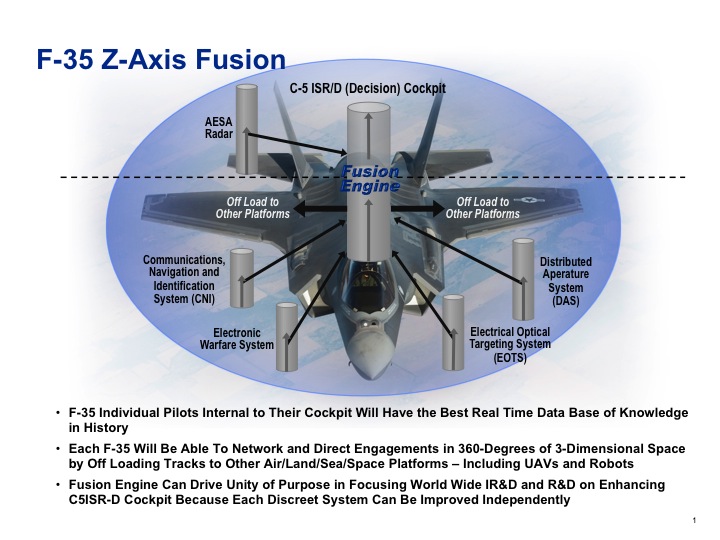
The “Z” axis is the pilot’s cockpit OODA loop axis.
Starting at the beginning from air fleet Command and Control during WWI C&C has morphed into C5ISR (getting silly) – Command, Control, Communications, Computers, Combat Systems, Intelligence, Surveillance, and Reconnaissance
Traditionally, in looking at the progression of aircraft a two-dimensional design depiction has been used; the x-axis or horizontal axis is time and the horizontal y-axis is enhanced technology performance.
That type of graph captures individual airplanes in generational shifts.
Combat aircraft tend to cluster in generation improvements. Each aircraft clustered in a “generation” is only a combination of platform airframe/ engine improvements.
The aeronautical design “art” of blending together ever improving and evolving technology creates improvements in a linear fashion, if not performance would eventually go asymptotic.
The airframe design characteristics blended together prior to F-35 have been constantly improving range, payload (improved by system/and weapons carried), maneuverability (measured by P Sub s), speed, and range (modified by VSTOL–a basing mobility plus factor).
The F-35 is also designed with inherent survivability factors, redundancy and hardening and stealth. Stealth is usually seen as the 5th Gen improvement.
But reducing the F-35 to a linear x-y axis improvement simply misses the point.
The F-35 is now going to take technology into a revolutionary three-dimensional situational awareness capability.
This capability establishes a new vector for TacAir aircraft design, embracing software upgradeable platforms and weapons.
This can be measured by a three-dimensional plot incorporating a “Z” axis.
The “Z” axis of cockpit fusion engine dynamics of incorporating software upgradeable system performance is a new R&D vector in combat aircraft design. In brings the OODA into a marriage with advanced technology sensing and hence more effective payload delivery.
Like Boyd using his F-86 for OODA, the F-35 is not only advanced OODA, but platform OODA for OODA sake is not enough, because now the payload carried by the combat force is everything.
It is now much more than a gun or early AA missiles, which constrained Boyd’s thinking.
Just like the example of laser guiding a bomb to destroy the Paul Doumer Bridge, a new chapter in technology and warfare has been captured in the fifth generation combat world by two USMC Fighter Pilots.
The first is Lt. Col. Chip Berke-USMC-a former Top Gun Instructor, USAF F-22 exchange Pilot and CO ofVMFAT-501 a USMC F-35 Squadron quipped in an open discussion when challenged by an F-22 pilot-
“I will win the fight because “I will fry you before you see me.”
The second was underscored in our discussion with then Major Greg Summa a USMC XO of an F-35 Squadron who as an F/A-18 pilot had attended the Navy Fighter Weapons School (TOPGUN) and completed the Strike-Fighter Tactics Instructor (SFTI) Course said in flying the F-35 on a range against enemy capabilities-
For example, if I need an electronic warfare tool set, with the F-18 I have to call in a separate aircraft to provide for that capability.
With the F-35 I have organic EW capability.
The EW capability works well in the aircraft.
From the time it is recognized that such a capability is need to the time that it is used requires a push of a button.
Consequentially the “F/A/E”-35 can both fire/drop kinetic weapons or radiate directed “trons” as a payload function a truly new technology age is upon us.
Historically, Command and Control (C&C) was external to 1,2,3, 4th and some 5th Generations of TacAir. Now way overly complicated known as C5ISR the goal was still enhancing fleet wide combat performance for all Type/Model/Series (T/M/S) of TacAir.
This is the historic AWACS and Red Crown (USN ship) hub and spoke battle management concept.
But by using a three-dimensional graph, one can understand that a “Z-axis” (3 dimensional plot) takes airpower into a totally different design domain.
The shift can be exemplified by ditching C5ISR and going back to the need for the best robust and survivable higher echelon Command and Control (C&C or C2).
Setting aside Admirals like to be Admirals and Generals like to be Generals, “commanders guidance” will eventually evolve to empower independent action and combat deeds at the operator level. Fortunately American think like that and this is the revolutionary step function that breaks the linear progression of previous generations.
The “Z” axis in which the F-35 is the prototype is the first fusion 360 “reach not range” information into the individual cockpits. Not only does this enhance the Payload utility of the indigenous weapons carried but such a capability unifies and empowers a fleet wide target acquisition capability and target engagement capability. Put in other words, the ability to tap into the resources of the entire combat fleet can be energized.
For example, as stated previously I briefed “Aegis is my wingman” and “an SSG(N) is my fire support” to the Air Force Association Conference. The power of that statement is seen in a previous Chief of Staff of the USAF discussing one shooter having the missile launched but captured by a sensor for guidance to a kill.
This is the dawn of a new Pu paradigm.
A design focus of F-35 is the cockpit, and helmet displays of trusted fused integrated systems. Enabled with that technology the pilot can also be a distributed information decision-maker.
This is the Z axis in action and the enabler is the trusted “fusion engine.”
Fleet wide information sharing among services and allies may be a huge factor in winning an air campaign and a war.
The Payload-Utility Dynamic And the Kill Web: Leaving the Legacy Kill Chain in the Rear View Mirror
Therefore my latest research, which is an attempt to bring focus on a simply stated observation, has profound complexities in execution.
Payload utility can be a driver for understanding the future development of combat systems.
To understand Pu with full honor to John Boyd, it can be noted that Observe/Orient (OO) is essentially target acquisition, and Decide/Act (DA) is target engagement.
Thus there is a very simple formula, better and better TA and TE =more effective employment of all payloads available to the battle commander.
It is the process of understanding the huge complexities in such a simple formula that is the challenge.
Understanding the technology and human dynamic through an analytic filter of a Payload Utility function consisting of weapons (kinetic and TRON) and the dual components of Target Acquisition (TA) and Target Effectiveness (TE) effectiveness in a fighting fleet engaged in high intensity combat in the unforgiving cauldron of battle maybe a war winner.
Either in one platform, or melded into a unified fighting Fleet to bring all different types of appropriate “weapons on” for the kill shot is a powerful concept.
America must always appreciate that no platform should fight alone if the Wynne Doctrine, named for 21st Century Secretary of Air Force, is employed: “If it is a fair fight someone failed in planning.”
A very simple filter to look at platform and weapon development within the integration of current weapon systems and platforms is asking the largest questions possible and pursuing force design and operational answers to these questions:
What does weapon or system add to fleet Pu?
How does this system help in TA?
How does this system help in TE?
What is the best weapon for the highest Pk against the target?
Is the TA, TE and Weapons (kinetic and Tron) carried together F-35 or separate?
If separate such as P-8 and fleet being aided by UAS Triton is the C&C robust enough to keep both the single engagement and also the overall battle focused with “weapons free”?
The demonstrated performance of all weapons and systems working together becomes of paramount importance because everything must be in support of a successful kill shot or what one might consider to be a kill web, rather than a legacy kill chain.
Information collected without full understanding of the unifying driver of integrating the proven utility of all payloads may simply lead to a disaggregated numbers game against the PLAAF and PLAN.
And in that game, the great but also true cliché comes into play: “Quantity has a quality of its own.”
Boyd had a very powerful message in his lecturing about advanced technology; he complained that it just doesn’t work.
The corollary to that point is that he was 100 % correct but eventually American technological virtuosity and diligence can produce the best weapons in the world that do work.
In this sense, quality has a significant impact all on its own as well.
My AIM-7 Sparrow was a perfect “water seeker” on a missile shoot but gave way to the excellent AIM-120 AMRAAM
Consideration of TA and TE in contributing to Payload Utility (Pu) allows an analysis of the appropriate integration of people, sensors and weapons.
Understanding the technology and mission trade-off by platforms in the continuum of TA and TE could be a structured way ahead for understanding and analyzing 21st Century man-machine information and learning dynamics.
Beginning with the F-35 and branching out to all platforms in a fleet it is my working hypothesis that the F-35 can actually be the driver in moving from intellectually constrained linear thinking about “kill chains” into the new dynamic of “kill webs.”
This is way beyond just effects based outcome analysis in that Pu incorporates consideration all systems coming to the fight, inside a “Kill Web” driver.
Rear Admiral Manizer, the former N-9, nailed the shift in thinking planning training for empowering “Kill Webs”:
“One of the key aspects of changes involves weapons in the kill web. Target identification and weapons delivery will not be necessarily located on the same platform.
“Indeed, the ability to deliver lethal effect in the electro-magnetic battle space will be distributed throughout the kill web.
“Weapons are distributed throughout the kill web and can be fired by platforms also operating throughout the kill web capable of firing weapons not carried by that platform.
Distributed strike will become increasingly significant as well as weapons modernization accelerates and the problem of providing new capabilities to the force, a force that is distributed in operations.”
There are several significant force design considerations, which flow from a payload-utility kill web approach.
If Payload/Utility was the driver year back then the Littoral Combat Ship would have been looked at differently-what TA, TE and Pu does it bring to the fleet-or is an expensive one off?
There is not sufficient knowledge of emerging fleet TA, TE and hence better Pu on ranges to design a 6th Gen Fighter, whatever that means.
Currently the U.S. and core allied militaries is in an “applied physics” phase of 21 Century combat development, the early 21st Century information revolution could be considered the ‘theoretical physics” phase.
I firmly believe that embracing the central theme of a payload utility function can greatly help resolve the laundry list of technological complexities in the “3rd Off Set Strategy”” which was in vogue during the Obama Administration.
Payload/Utility is “Kill Web” compatible; “Kill Chain” is simply linear thinking.
Keeping ideas simple is a gift to all in creating the most effective military in the world.
For clarity of first building a combat capable military one may also set aside a lot of Sun Tzu’s profundity.
He is often quoted to confuse or divert from the central focus of what is brutally quipped as the first purpose of the USMC, by Marines— support equip and train “A Big Green Killing Machine.”
Although, General/Philosopher Tsin Szu did get one thing absolutely right; “Victory usually goes to the army who has better trained officers and men.”
A little noted American President James A Garfield was a combat veteran fighting in vicious battles as the country was torn asunder.
From his history; Garfield opposed Confederate secession, served as a major general in the Union Army during the American Civil War, and fought in the battles of Middle Creek, Shiloh, and Chickamauga.
He made a profound and lasting statement about ideas: Ideas are the great warriors of the world, and a war that has no idea behind it, is simply a brutality.
Editor’s Note: And to put this into a very real world context, new aviation assets are being morphed into a more effective maritime combat force.
As Admiral Swift has recently noted with regard to the current Korean situation:
The U.S. would continue deploying heavy firepower to the region, including “carrier strike groups, expeditionary strike groups, AEGIS ships, the world’s most capable submarine force and advanced aircraft like the F-35, P-8 and MH-60R..
“Let our potential adversaries take pause and note that the only naval force more powerful than the U.S. Pacific Fleet is the entirety of the United States Navy.”
For a Special Report which examines the applied physics side of transformation discussed by Timperlake, see the following Special Report on the Maritime Services, the Allies and the Kill Web.
Please enter your name and email below and you will then be able to download the report directly.



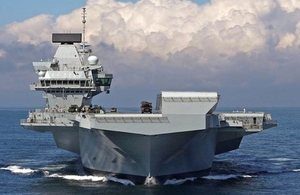 HMS Queen Elizabeth, the UK’s new aircraft carrier, which was block built around the country. Credit: UK MoD
HMS Queen Elizabeth, the UK’s new aircraft carrier, which was block built around the country. Credit: UK MoD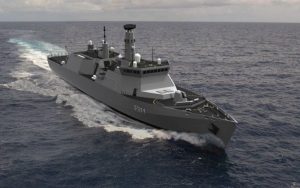 How the new Type 31e frigates might look. Credit: Daily Telegraph
How the new Type 31e frigates might look. Credit: Daily Telegraph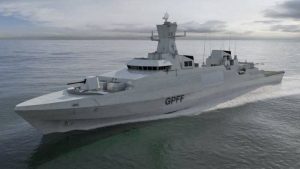
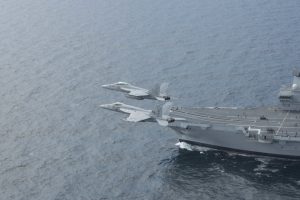 ATLANTIC OCEAN (Aug. 5, 2017) An F/A-18E Super Hornet attached to the “Tomcatters” of Strike Fighter Squadron (VFA) 31, bottom, and an F/A-18F Super Hornet attached to the “Blacklions” of VFA-213 fly in formation above the HMS Queen Elizabeth (R08) during exercise Saxon Warrior 2017, One aspect of shaping the kill web will be flying with an all fifth generation carrier (the Queen Elizabeth) with large deck US carriers which carry a mixed 4th/5th gen force and with the new USS America which will fly F-35s as its strike aircraft.
ATLANTIC OCEAN (Aug. 5, 2017) An F/A-18E Super Hornet attached to the “Tomcatters” of Strike Fighter Squadron (VFA) 31, bottom, and an F/A-18F Super Hornet attached to the “Blacklions” of VFA-213 fly in formation above the HMS Queen Elizabeth (R08) during exercise Saxon Warrior 2017, One aspect of shaping the kill web will be flying with an all fifth generation carrier (the Queen Elizabeth) with large deck US carriers which carry a mixed 4th/5th gen force and with the new USS America which will fly F-35s as its strike aircraft.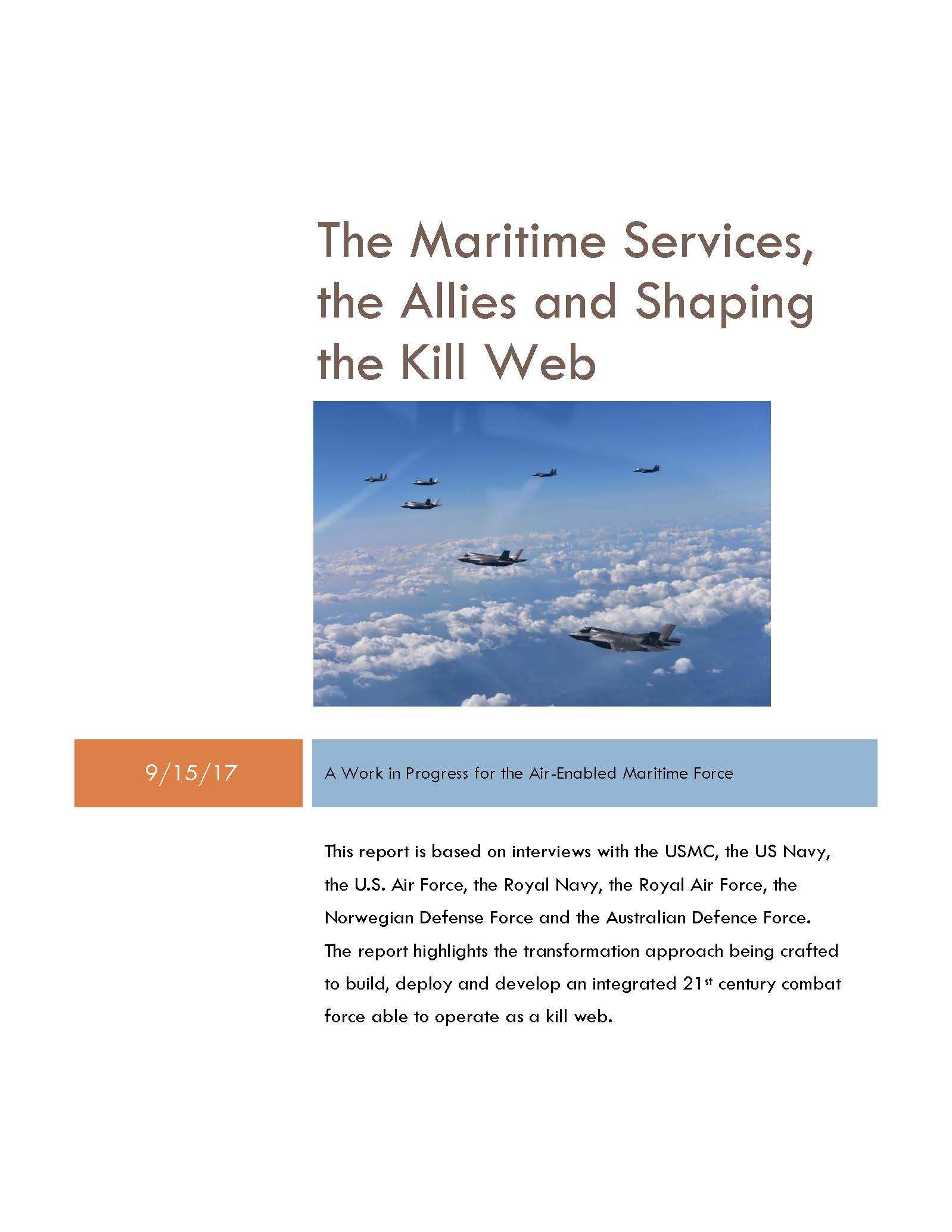
 USMC F-35Bs fly with USAF strategic bombers and South Korean F-15Ks during a 10-hour mission from Andersen Air Force Base, into Japanese airspace and over the Korean Peninsula, August 30th. This mission was conducted in direct response to North Korea’s intermediate-range ballistic missile launch, which flew directly over northern Japan on August 28 amid rising tension over North Korea’s nuclear and ballistic missile development programs. (Photo by Republic of Korea Air Force). The F-35Bs could come from a fixed airfield, an airfield dispersed in an island chain or launched from a ship. That is the advantage of flying an F-35B in the age of the kill web.
USMC F-35Bs fly with USAF strategic bombers and South Korean F-15Ks during a 10-hour mission from Andersen Air Force Base, into Japanese airspace and over the Korean Peninsula, August 30th. This mission was conducted in direct response to North Korea’s intermediate-range ballistic missile launch, which flew directly over northern Japan on August 28 amid rising tension over North Korea’s nuclear and ballistic missile development programs. (Photo by Republic of Korea Air Force). The F-35Bs could come from a fixed airfield, an airfield dispersed in an island chain or launched from a ship. That is the advantage of flying an F-35B in the age of the kill web.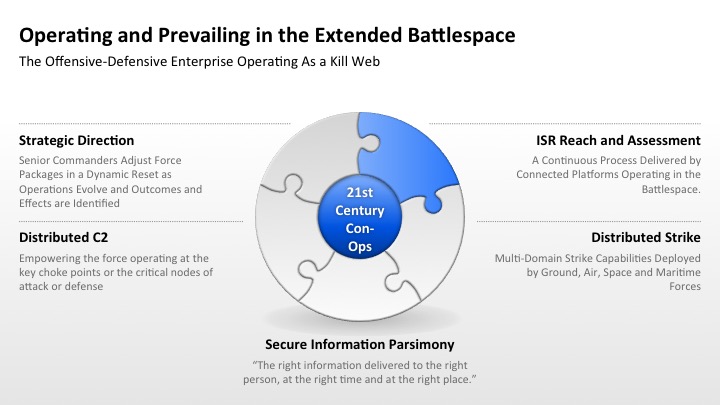
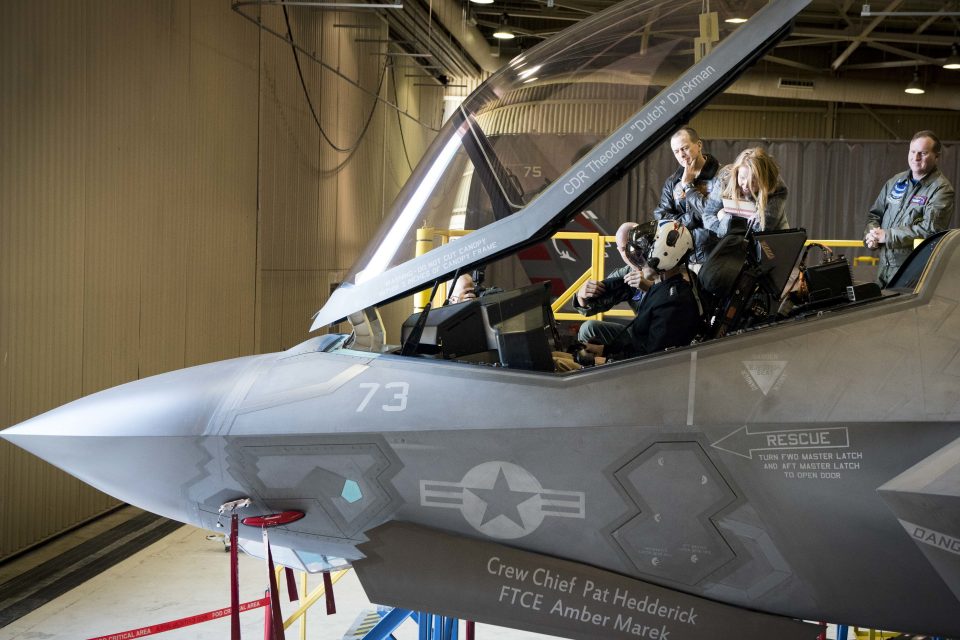
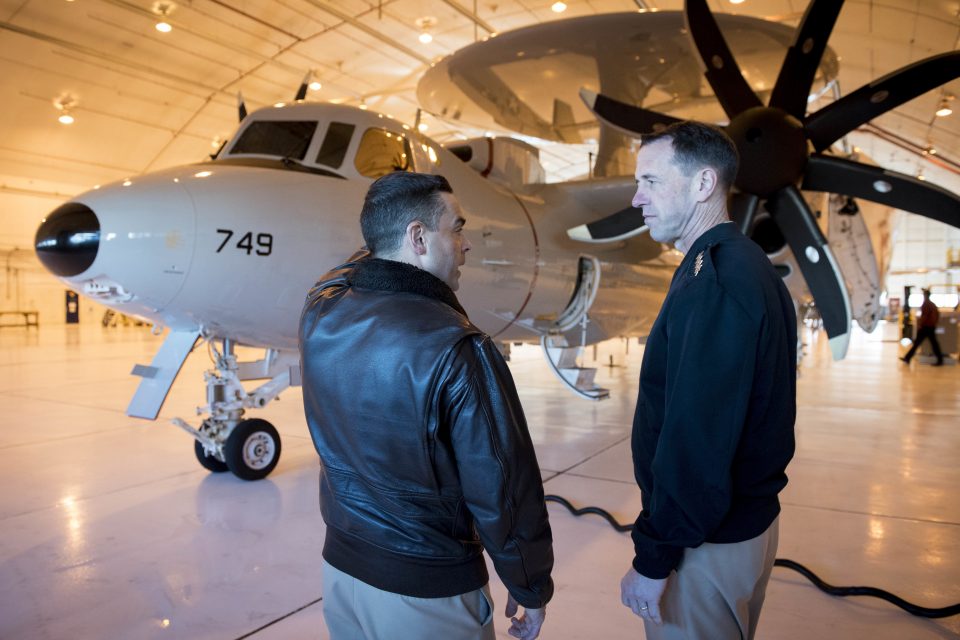
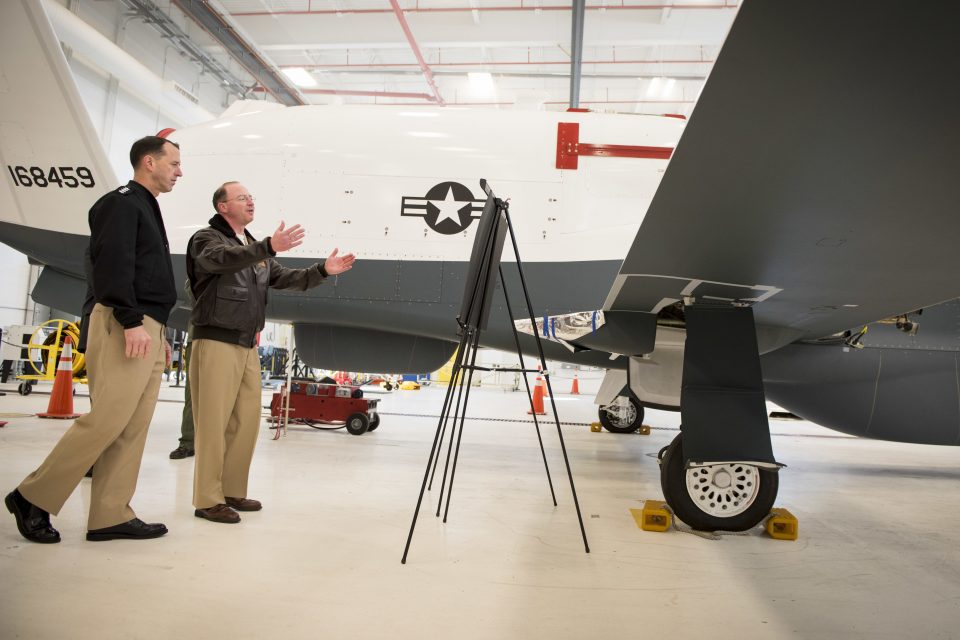
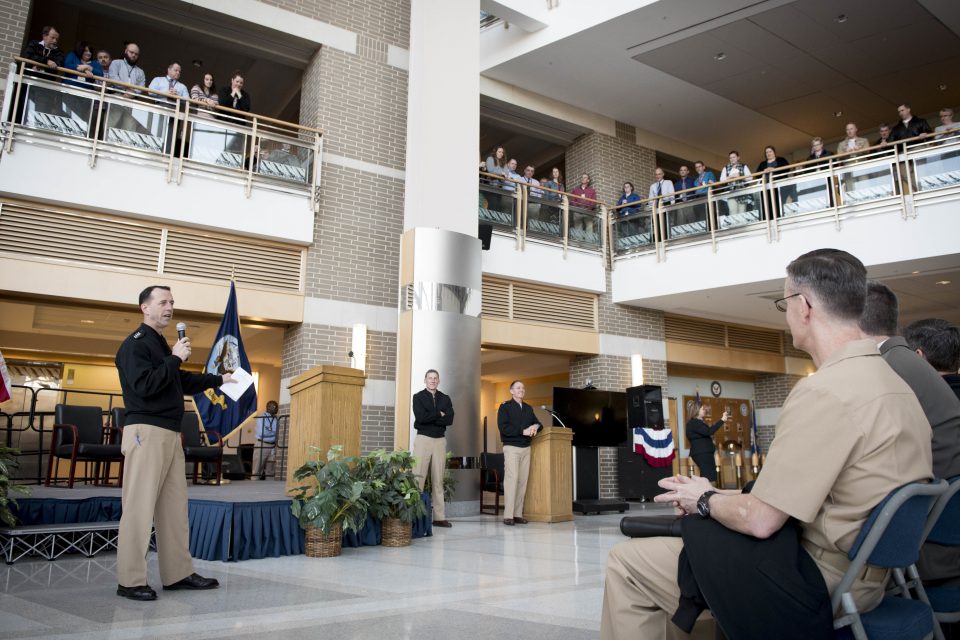
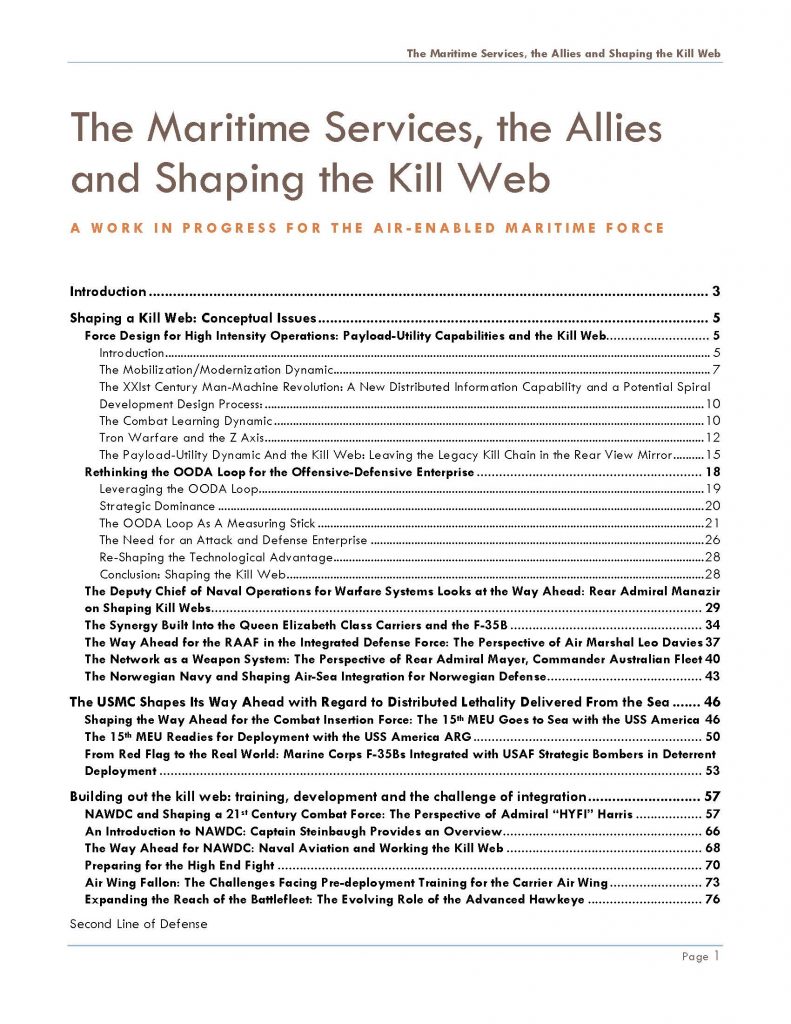
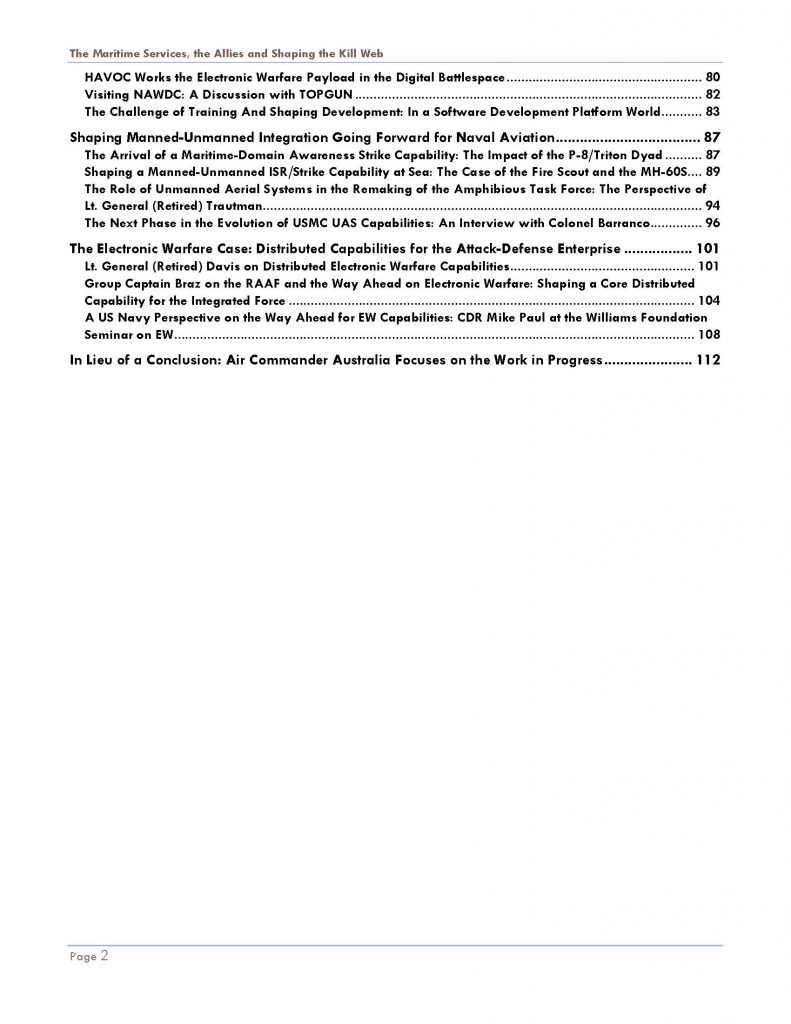


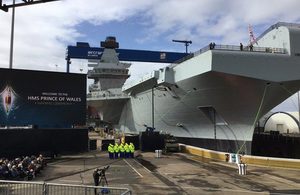 HMS Prince of Wales. Credit: UK MoD
HMS Prince of Wales. Credit: UK MoD